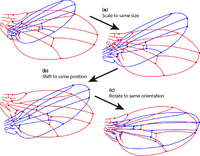Procrustes analysis

Procrustes analysis is like playing a matching game but with shapes instead of colors or pictures. Let's say you have two different shapes – one is a teddy bear and the other is a giraffe. You want to see if they have similar shapes even though they look different.
First, you need to make sure that they are the same size by stretching or shrinking them. This is just like making sure that when you match a puzzle piece, it fits perfectly with the others. Then you rotate and move one of the shapes to see if it aligns with the other shape. Just like how you might try different pieces to see if they fit together.
Procrustes analysis does the same thing, but with mathematical calculations. It looks at the shapes of two different objects and makes them the same size, rotates and moves them, and sees how well they match up. It's like a game of shape matching, where the goal is to find the best fit between two objects by adjusting their shape, size, and position.
Scientists use Procrustes analysis for many things like studying how animal bones vary in shape or analyzing how different people's faces move. By using this method, they can more easily compare different shapes and see how they relate to each other.
First, you need to make sure that they are the same size by stretching or shrinking them. This is just like making sure that when you match a puzzle piece, it fits perfectly with the others. Then you rotate and move one of the shapes to see if it aligns with the other shape. Just like how you might try different pieces to see if they fit together.
Procrustes analysis does the same thing, but with mathematical calculations. It looks at the shapes of two different objects and makes them the same size, rotates and moves them, and sees how well they match up. It's like a game of shape matching, where the goal is to find the best fit between two objects by adjusting their shape, size, and position.
Scientists use Procrustes analysis for many things like studying how animal bones vary in shape or analyzing how different people's faces move. By using this method, they can more easily compare different shapes and see how they relate to each other.
Related topics others have asked about:
